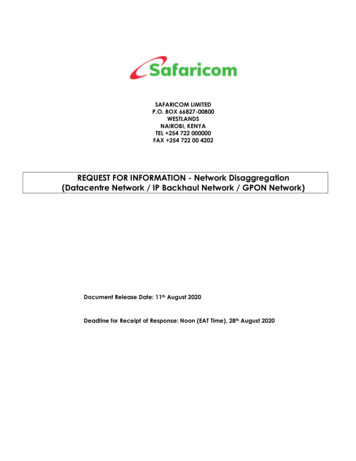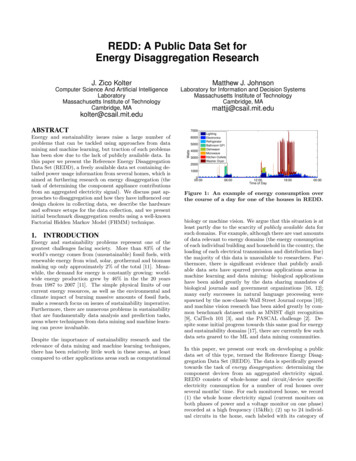
Transcription
SAFARICOM LIMITEDP.O. BOX 66827-00800WESTLANDSNAIROBI, KENYATEL 254 722 000000FAX 254 722 00 4202REQUEST FOR INFORMATION - Network Disaggregation(Datacentre Network / IP Backhaul Network / GPON Network)Document Release Date: 11th August 2020Deadline for Receipt of Response: Noon (EAT Time), 28th August 2020
CONTENTS1.INTRODUCTION . 32.OBJECTIVES. 33.DRIVERS . 34.SCOPE . 35.TECHNICAL REQUIREMENTS . 45.1.Domain Specific Requirements . 45.1.1.Datacenter Network. 45.1.2.IP Backhaul Network (Cell site gateways, Aggregation Routers) . 45.1.3.GPON Infrastructure (xPON Open Networking). 55.2.Generic requirements (All Domains) . 66.ADDITIONAL INFORMATION . 87.NEXT STEPS . 88.RESPONSES . 89.NOTES TO SUPPLIERS: . 8
1. INTRODUCTIONSafaricom PLC is the leading mobile services provider in Kenya and has a steadily growingsubscriber base. Safaricom is continuously expanding and upgrading its systems and processesto meet the changing needs of its customers. To meet this objective Safaricom continuouslyseeks to partner with competent suppliers and service providers on various requirements.Safaricom PLC now intends to engage the services of competent and reputable companieswith deep expertise in disaggregated networks design, build and operations.2. OBJECTIVESThe objective for this RFI is to investigate the breadth of the Disaggregated Networks Hardware& Software market. A key objective of this exercise is to evaluate if this market is sufficientlymature and broad enough to provide adequate solutions for the various network domains ascaptured in the scope below. At the end of the exercise a list of bidders will be prequalified whowe can potentially work with in a POC that will later lead to an RFP process.3. DRIVERSa.b.c.d.e.Scale: Support for network capacity growth in the various domainsOpenness: Decoupling of hardware and software lifecycle through ensuring cross vendorhardware / software compatibility and hence use of hardware and software from differentproviders and use open management interfaces and protocolsSimplified management tools: use of common DEVOPS tools for network management.Evolution path to SDN.Efficiency: Platform performance vs Infrastructure cost, reduction in Space, power&cooling requirements.4. SCOPENetwork Disaggregation has seen substantially growth in the ICT and telecommunicationsindustry. Initially, providing solutions for the data center servers it has now found its way down tothe network edge. Below are the network domains that we are interested at looking for thesesolutions.a) Datacenter Networksb) IP Backhaul Networkc) GPON Infrastructure (xPON)
5. TECHNICAL REQUIREMENTS5.1.Domain Specific Requirements5.1.1.Datacenter NetworkThe datacenter network provides connectivity between compute elements within thedatacenter (east-west traffic) as well as connectivity to external elements (north-south traffic).The deployment would be done in our main datacenters as well as the edge computinglocations.The supplier shall provide information in relation to the requirements below which are the keyfeatures & functionality that the Network needs to support.a) Leaf-spine architecture. The supplier shall show the recommended solution support for Leafspine architecture which is a two-layer network topology composed of leaf switches andspine switches.b) Virtual extensible Local Area Network (VXLAN) The solution should support Virtual extensibleLocal Area Network (VXLAN): A Framework for Overlaying Virtualized Layer 2 Networks overLayer 3 Networks as defined in the IETF standards RFC 7348 and the other related standardsc) VXLAN BGP-EVPN The solution should support VXLAN BGP-EVPN solution based on MP-BGP,as described in RFC 4760d) The supplier shall describe the supported switch fabric and packet forwarding architectureand performance.e) Data rates supported. The supplier shall indicate maximum number of interface typessupported on the proposed switch platform (1G, 10G, 40G, 100G, FCOE)f)Support for both IPv4 & IPv6g) The proposed CEs/Data Center Switches shall support OSPFv2 and OSPFv3 routing protocolas specified in the respective RFCh) The proposed CEs/Data Center Switches shall support BGP routing protocol as specified inthe respective RFCi)The proposed CEs/Data Center Switches shall support MPLS L3VPN [IPv4 & IPv6] & L2VPN asspecified in the respective RFCj)Multicast support5.1.2.IP Backhaul Network (Cell site gateways, Aggregation Routers)The objective of the target network is to implement an IP/MPLS network which will provideflexibility, resiliency and ease the implementation of existing and new services in the network. At
a high level, the IP/MPLS network equipment should support these features; L2VPN services,L3VPN services, Multicast, Synchronization, and Security.The supplier shall provide information in relation to the requirements below which are the keyfeatures & functionality that the Network needs to support.a) The intra-domain routing within each of the MPLS domains (i.e. aggregation domains andcore) SHOULD utilize standard IGP protocols like OSPF or ISIS. The intra-domain MPLS LSP setupand label distribution SHOULD utilize standard protocols like LDP or RSVP. Service routingshould be based on BGP.b) Hierarchical design with Multi-Domain (and Multi-vendor) MPLS networks - that enables theseamless exchange of loopback addresses and MPLS label bindings for transport LSPs acrossthe entire MPLS internetwork while at the same time preventing the flooding of unnecessaryrouting and label binding information into domains or parts of the network that do not needthem.c) Segment routing (SR-MPLS TE/SRv6) support with demonstrated capability for interaction withLDP, RSVP and MPLS.d) Network should support the Seamless MPLS architecture ss-mpls-07)e) L3VPNs (IPv4 & IPv6)f)L2VPNs (P2P, VPLS, BGP-EVPN)g) Multicast supporth) Data rates supported (1G, 10G, 40G, 100G)i)IP Network synchronization protocols support: Sync-E & PTP (8265 or 1588v2)5.1.3.GPON Infrastructure (xPON Open Networking)A key goal of Safaricom’s envisioned strategy for FTTx is to be able to decouple xPON solutionhardware and software roadmaps, in compliance with open networking initiatives therebyleading to more flexibility and open market opportunities with lower total cost of ownership.Safaricom would also like to benefit from the operational efficiencies that can be derived fromSDN-capable OLTs.The supplier shall provide information in relation to the requirements below on disaggregatedOLT hardware and software. These are the key features & functionality that the OLT equipmentneeds to support.a) Compliance with leading open networking initiatives such as Virtual OLT HardwareAbstraction (VOLTHA), SDN Enabled Broadband Access (SEBA), R-CORD etc.b) Must have SDN & NFV capabilities.
c) Standards compliance:i.ii.iii.Must be compliant with ITU GPON, XGSPON and ONU Management & Controlinterface-related specifications.Should be compliant with IEEE Ethernet-related specifications and Metro EthernetForum specifications.Should be compliant with IETF IGMP & DHCP related standards.d) Interoperability: The OLT should be interoperable and certified to work with leading ONUvendors.e) Scalability. The OLT hardware must be highly flexible, modular, scalable and have a nonblocking architecture.f)OLT Hardwarei.Should support different form-factors with different port densities.ii.Should support up to 1:256 split ratio on a PON.iii.Chassis-based hardware should have the possibility to mix GPON, XGSPON, andNGPON2 in the same chassis.iv.Should offer a smooth migration path from GPON to XGSPON to NGPON2 withoutthe need for a complete forklift upgrade or rip and replace approach of theentire chassis.v.Must support OLT software from multiple vendors.vi.Data rates supported on uplinks (1G, 10G, 40G, 100G)g) OLT Software Must be supported on multiple Whitebox OLT hardware types from differentOEMs.h) Security. Should provide security mitigations including: DDOS attack protection, anti-ICMP/IPattack, MAC & IP address anti-spoofing.i)5.2.Support for both IPv4 & IPv6Generic requirements (All Domains)The supplier shall provide information in relation to the requirements below applicable to all thedomains.a) Software and hardware must be decoupled. Supplier should provide information onHardware / software solutions compatibility with other supplier’s hardware / software.b) Supplier should provide information on industry organization that they are a part of andthose that have validated their solutions (e.g. OCP Open Compute Project, LinuxFoundation, Open Networking Foundation, Telecom Infra Project)c) Software Defined Networks: the hardware and software platform should be SDN ready(RFC7426)d) Network QoS mechanisms supported
e) OSS & Managementi.Network management using an upstream element management system which mustprovide fault, configuration, accounting, performance and security management.ii.Support for SNMPv3iii.Support for standard northbound open interfaces for integration with third party OSS/BSSsystems via NETCONF/YANG, RESTCONF, documented REST APIs etc.iv.Configuration management using common tools e.g. Ansible/Chef/Puppet configurationtemplates.v.Network API inclusion on both hardware and softwarevi.Network programmability using common scripting languages e.g. Pythonvii.Network telemetry support aside from SNMP capability.f)i.Environment & Power considerationsCompliant with IEC and ETS and other environmental, power, acoustic and safetystandards.g) Servicesi.Professional services. Supplier to show case the services offered to enable the customerdesign and build disaggregated networksii.Support frameworks and services Supplier to provide information on support frameworksthat they use to ensure delivery of support services as per SLA.iii.Training & skills development. Supplier to showcase the programs available for upskillingof the teams that are required to design, build and support disaggregated networks.
6. ADDITIONAL INFORMATIONInterested firms must provide information to show their suitability for the high-level requirementsRequirement1Overall Company profile (if a company), clearly indicate theprincipal place of business.2Provide case studies / customer references of deploymentsdone within the last 3 years.3For cases where the OEM is working through partners, providedetails of this and the capabilities of the partners.4Comments &AttachmentsWhere a hardware provider is giving an E2E managed solutionthat includes software or vice versa, provide details of thispartnership arrangement.7. NEXT STEPSa) Review of submitted responsesb) Prequalification of shortlisted suppliers. Institutions that express interest to participate in theprovision of the above-mentioned service, and meet our requirements, shall be prequalifiedfor the provision of this networks in their area / domain(s) of expertise, subject to the provisionof required documentation and demonstrated ability.8. RESPONSESAll responses should be provided in electronic format only i.e. emailed toSNdubi@safaricom.co.ke , JKiremana@Safaricom.co.ke and lgachuhi@Safaricom.co.ke9.NOTES TO SUPPLIERS:a) Only the suppliers who meet our minimum requirements will be considered for furtherdiscussions.b) Build a detailed response showcasing what firm’s capacity and experience in offeringdisaggregated networks solutions in the fields described in this RFI document.c) Outline any industry best practices and trends that your organization may consider relevantfor Safaricom’s considerations.d) The RFI response must not include any pricing/commercial proposal.e) Safaricom reserves, at its sole discretion, the right to select or reject, either in totality orpartially, any or all proposals made in the context of this RFI. Any such decisions made will befinal and no correspondence will be engaged into, other than to informing the bidders ofthe outcome of the process.
f)The receipt of a response shall not bind Safaricom into any contractual agreements with thebidder. Such arrangements shall only come into place once an award is issued and thebidder is successful as evaluated technically and commercially. Any costs associated withthe preparation and submission of the response to the RFI shall be borne by the vendor.g) Safaricom and its authorized representatives are hereby authorized to conduct any inquiriesor investigations to verify the documents and information submitted in connection with thisRFI.h) All responses should be provided in standard file formats i.e. PPTs, XLSs, DOC(X), PDFi) Suppliers who wish to provide bulk documents using share drives MUST use OneDrive.Documents submitted using public share drives will not be accepted.j) Any costs associated with the preparation and submission of the response to the RFI shall beborne by the vendor.k) State if you submit this RFI as a joint venture/consortium or any other joint formatYours faithfully,FOR: SAFARICOM PLCLydia GachuhiSenior Manager – Purchasing
spine architecture which is a two-layer network topology composed of leaf switches and spine switches. b) Virtual extensible Local Area Network (VXLAN) The solution should support Virtual extensible . a high level, the IP/MPLS network equipment should support these features; L2VPN services, L3VPN services, Multicast, Synchronization, and .










